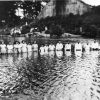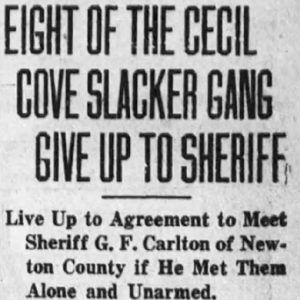calsfoundation@cals.org
Newton County Draft War
The Newton County Draft War was the last armed incident of the documented Arkansas draft wars, as well as one of the most colorful, as word of the “Cecil Cove Slackers” spread to national publications. In 1918, Newton County—located in the Ozark Mountains—was one of the most isolated and least developed regions in Arkansas, not yet crossed by railroads or serviceable highways. The Cecil Cove region—twelve miles long and eight miles wide, bordered by steep cliffs and caves, and only traversable by foot or mule—was an exceptional hiding spot. In the last months of World War I, several draft resistors in the region successfully eluded authorities.
Later interviews with the deserters outline a now familiar refrain for draft resistance in Arkansas during World War I: a “combination of plain ignorance, Jeff Davis politics, The Appeal to Reason, and mountain religion.” A number of young men from the Cove were selected in the first draft of June 5, 1917, but refused to report for duty; efforts to punish draft resisters did not begin in earnest until the spring of 1918. Given the rugged terrain and close-knit, interrelated community in the region, it is unlikely that the sheriff would have been able to assemble a nearby posse and then apprehend the resisters, all of whom had reputations as snipers, without considerable bloodshed. Four U.S. marshals, several special investigators, and an army colonel visited Cecil Cove but were unable to coerce the so-called slackers peacefully or by threat of force. One deputy even declared it would be “nothing short of suicide” to attempt to capture the slacker gang.
One reason local law enforcement was unable to make a concerted push against the resisters was the assistance from the townspeople. Cecil Cove was a heavily interrelated part of the state, and seemingly everyone had agreed to aid the resisters and/or frustrate the attempts to apprehend them. By the time an officer at Camp Pike in North Little Rock (Pulaski County) began agitating to take a contingent of soldiers to Cecil Cove, the Department of War—seeing the end of the war near—decided to cut its losses and, in September 1918, offered something like amnesty: a charge of desertion would not be pressed if the resisters gave themselves up and reported for duty for sixty days. The newly elected sheriff of Newton County, Frank Carlton, presented the deal to the gang members, and they agreed. It is unknown how many deserters originally made up the Cecil Cove Slackers, but eight men remained when the gang capitulated.
The Cecil Cove Draft War is notable for being largely bloodless—the twelve-year-old brother of Joe Arnold, one of the deserters, was hit in the leg by a stray bullet, but no one else was injured or killed. The incident is also noteworthy for being the only Arkansas draft war to achieve something of a victory for the draft resisters, unusual conditions which could not have been met if not for the seclusion of Cecil Cove and the near-universal support the resisters received from their community.
For additional information:
Sealander, Judith. “Draft Resistance in Arkansas to World War I” Ozark Historical Review 2 (1973): 1–12.
“Uncle Sam’s Little War in the Arkansas Ozarks.” The Literary Digest 60 (March 8, 1919): 107–111.
Phillip Stephens
Fayetteville, Arkansas



 Newton County Draft War Article
Newton County Draft War Article 



Comments
No comments on this entry yet.